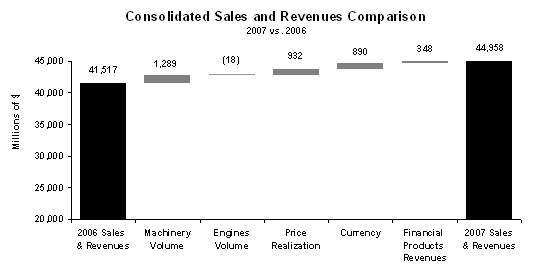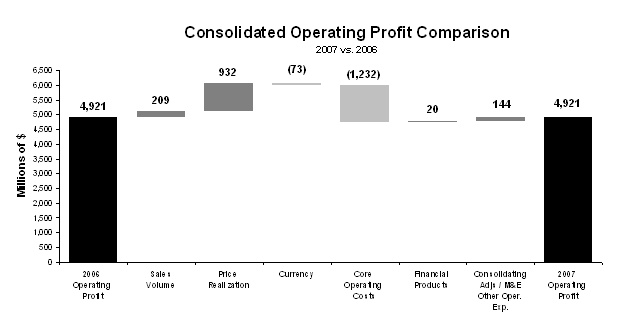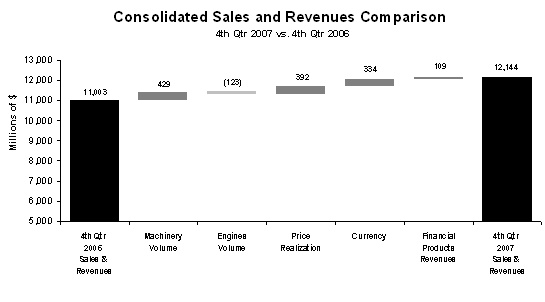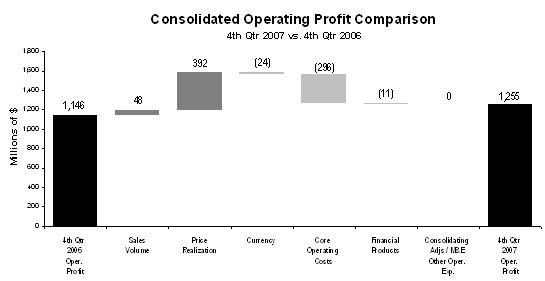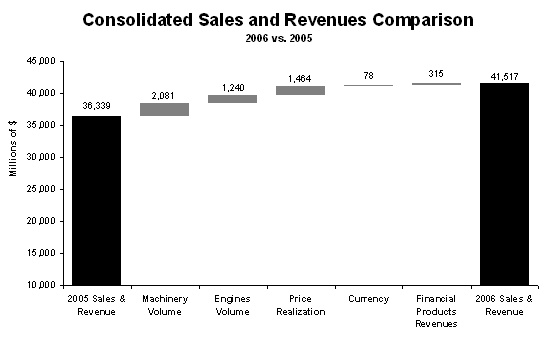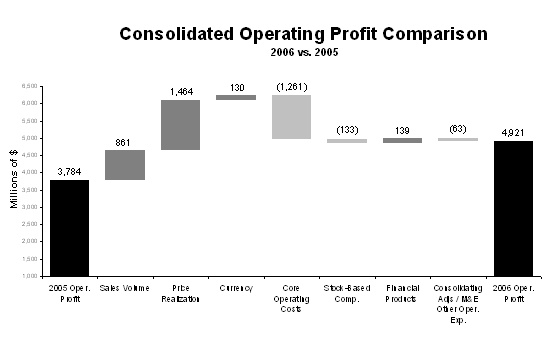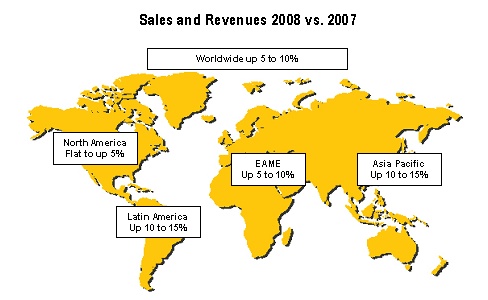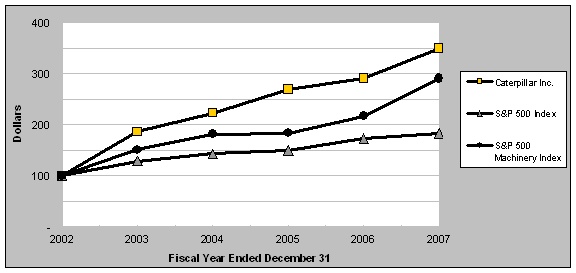Contractual obligations
| The company has committed cash outflow related to long-term debt, operating lease agreements, postretirement obligations, purchase obligations, interest on long-term debt and other long-term contractual obligations. Minimum payments for these obligations are: |
| (Millions of dollars) | 2008 | | 2009 | | 2010 | | 2011 | | 2012 | | After 2012 | | Total |
| Long-term debt: | | | | | | | | | | | | | | | | | | | | | | | | | | | |
| | Machinery and Engines (excluding capital leases) | $ | 178 | | | $ | 315 | | | $ | 1 | | | $ | 374 | | | $ | 1 | | | $ | 2,880 | | | $ | 3,749 | |
| | Machinery and Engines-capital leases | | 2 | | | | 2 | | | | 2 | | | | 2 | | | | 2 | | | | 60 | | | | 70 | |
| | Financial Products | | 4,952 | | | | 4,815 | | | | 2,961 | | | | 686 | | | | 1,515 | | | | 4,213 | | | | 19,142 | |
| | | Total long-term debt | | 5,132 | | | | 5,132 | | | | 2,964 | | | | 1,062 | | | | 1,518 | | | | 7,153 | | | | 22,961 | |
| Operating leases | | 248 | | | | 186 | | | | 155 | | | | 119 | | | | 95 | | | | 441 | | | | 1,244 | |
Postretirement obligations1 | | 770 | | | | 490 | | | | 490 | | | | 530 | | | | 550 | | | | 3,150 | | | | 5,980 | |
| Purchase obligations: | | | | | | | | | | | | | | | | | | | | | | | | | | | |
| | Accounts payable2 | | 4,723 | | | | — | | | | — | | | | — | | | | — | | | | — | | | | 4,723 | |
| | Purchase orders3 | | 6,186 | | | | — | | | | — | | | | — | | | | — | | | | — | | | | 6,186 | |
| | Other contractual obligations4 | | 250 | | | | 87 | | | | 65 | | | | 40 | | | | — | | | | — | | | | 442 | |
| | | Total purchase obligations | | 11,159 | | | | 87 | | | | 65 | | | | 40 | | | | — | | | | — | | | | 11,351 | |
Interest on long-term debt5 | | 1,001 | | | | 708 | | | | 555 | | | | 475 | | | | 405 | | | | 5,829 | | | | 8,973 | |
Other long-term obligations6 | | 119 | | | | 99 | | | | 73 | | | | 62 | | | | 62 | | | | 50 | | | | 465 | |
| Total contractual obligations | $ | 18,429 | | | $ | 6,702 | | | $ | 4,302 | | | $ | 2,288 | | | $ | 2,630 | | | $ | 16,623 | | | $ | 50,974 | |
| 1 | Amounts represent expected contributions to our pension and other postretirement benefit plans through 2017, offset by expected Medicare Part D subsidy receipts. |
| 2 | Amount represents invoices received and recorded as liabilities in 2007, but scheduled for payment in 2008. These represent short-term obligations made in the ordinary course of business. |
| 3 | Amount represents contractual obligations for material and services on order at December 31, 2007 but not yet delivered. These represent short-term obligations made in the ordinary course of business. |
| 4 | Amounts represent long-term commitments entered into with key suppliers for minimum purchases quantities. |
| 5 | Amounts represent estimated contractual interest payments on long-term debt. |
| 6 | Amounts represent contractual obligations primarily related to software license contracts, IT consulting contracts and outsourcing contracts for benefit plan administration and software system support. |
We adopted FIN 48, “Accounting for Uncertainty in Income Taxes” as of January 1, 2007. The total amount of gross unrecognized tax benefits for uncertain tax positions, including positions impacting only the timing of tax benefits, was $703 million at December 31, 2007. Payment of these obligations would result from settlements with taxing authorities. Due to the difficulty in determining the timing of settlements, FIN 48 obligations are not included in the table above. We do not expect a significant tax payment related to these obligations within the next year.
The preparation of financial statements in conformity with generally accepted accounting principles requires management to make estimates and assumptions that affect reported amounts. The more significant estimates include: residual values for leased assets, fair market values for goodwill impairment tests, warranty liability, stock-based compensation, reserves for product liability and insurance losses, postretirement benefits, post-sale discounts, credit losses and income taxes. We have incorporated many years of data into the determination of each of these estimates and we have not historically experienced significant adjustments. These assumptions are reviewed at least annually with the Audit Committee of the Board of Directors. Following are the methods and assumptions used in determining our estimates and an indication of the risks inherent in each.
Residual values for leased assets—The residual values for Cat Financial’s leased assets, which are based upon the estimated wholesale market value of leased equipment at the time of the expiration of the lease, represent a careful analysis of historical wholesale market sales prices, projected forward on a level trend line without consideration for inflation or possible future pricing action. At the inception of the lease, residual values are derived from consideration of the following critical factors: market size and demand, any known significant market/product trends, total expected hours of usage, machine configuration, application, location, model changes, quantities and past re-marketing experience, third party residual guarantees and contractual customer purchase options. During the term of the leases, residual amounts are monitored. If estimated market values reflect a non-temporary impairment due to economic factors, obsolescence or other adverse circumstances, the residuals are adjusted to the lower estimated values by a charge to earnings. For equipment on operating leases, the charge is recognized through depreciation expense. For finance leases, it is recognized through a reduction of finance revenue.
Fair market values for goodwill impairment tests— We test goodwill for impairment annually and whenever events or circumstances make it likely that an impairment may have occurred, such as a significant adverse change in the business climate or a decision to sell all or a portion of a reporting unit.
Determining whether an impairment has occurred requires valuation of the respective reporting unit, which we estimate using a discounted five year forecasted cash flow with a year-five residual value based upon a comparative market Earnings Before Interest, Taxes, Depreciation and Amortization (EBITDA) multiple. The assumptions about future cash flows are based on the reporting unit’s long-term forecast and are subject to review and approval of our senior management. The market EBITDA multiple is based on recent market transactions in the reporting unit’s industry. The estimated fair value could be impacted by changes in interest rates, growth rates, costs, pricing, capital expenditures and market conditions.
Warranty liability— At the time a sale is recognized, we record estimated future warranty costs. The warranty liability is determined by applying historical claim rate experience to the current field population and dealer inventory. Generally, historical claim rates are based on actual warranty experience for each product by machine model/engine size. Specific rates are developed for each product build month and are updated monthly based on actual warranty claim experience. Warranty costs may differ from those estimated if actual claim rates are higher or lower than our historical rates.
Stock-based compensation— We use a lattice-based option-pricing model to calculate the fair value of our stock option and SARs. The calculation of the fair value of the awards using the lattice-based option-pricing model is affected by our stock price on the date of grant as well as assumptions regarding the following:
| | · | Volatility is a measure of the amount by which the stock price is expected to fluctuate each year during the expected life of the award and is based on historical and current implied volatilities from traded options on Caterpillar stock. The implied volatilities from traded options are impacted by changes in market conditions. An increase in the volatility would result in an increase in our expense. |
| | · | The expected term represents the period of time that awards granted are expected to be outstanding and is an output of the lattice-based option-pricing model. In determining the expected term of the award, future exercise and forfeiture patterns are estimated from Caterpillar employee historical exercise behavior. These patterns are also affected by the vesting conditions of the award. Changes in the future exercise behavior of employees or in the vesting period of the award could result in a change in the expected term. An increase in the expected term would result in an increase to our expense. |
| | · | The weighted-average dividend yield is based on Caterpillar's historical dividend yields. As holders of stock-based awards do not receive dividend payments, this could result in employees retaining the award for a longer period of time if dividend yields decrease or exercising the award sooner if dividend yields increase. A decrease in the dividend yield would result in an increase in our expense. |
| | · | The risk-free interest rate is based on the U.S. Treasury yield curve in effect at time of grant. As the risk-free interest rate increases, the expected term increases, resulting in an increase in our expense. |
The fair value of our RSUs is determined by reducing the stock price on the date of grant by the present value of the estimated dividends to be paid during the vesting period. The estimated dividends are based on Caterpillar’s weighted-average dividend yields. A decrease in the dividend yield would result in an increase in our expense.
Stock-based compensation expense recognized during the period is based on the value of the number of awards that are expected to vest. In determining the stock-based compensation expense to be recognized, a forfeiture rate is applied to the fair value of the award. This rate represents the number of awards that are expected to be forfeited prior to vesting and is based on Caterpillar employee historical behavior. Changes in the future behavior of employees could impact this rate. A decrease in this rate would result in an increase in our expense.
Product liability and insurance loss reserve—Determined based upon reported claims in process of settlement and actuarial estimates for losses incurred but not reported. Loss reserves, including incurred but not reported reserves, are based on estimates and ultimate settlements may vary significantly from such estimates due to increased claims frequency or severity over historical levels.
Postretirement benefits—Primary actuarial assumptions were determined as follows:
| | · | The U.S. expected long-term rate of return on plan assets is based on our estimate of long-term passive returns for equities and fixed income securities weighted by the allocation of our plan assets. Based on historical performance, we increase the passive returns due to our active management of the plan assets. A similar process is used to determine the rate for our non-U.S. pension plans. This rate is impacted by changes in general market conditions, but because it represents a long-term rate, it is not significantly impacted by short-term market swings. Changes in our allocation of plan assets would also impact this rate. For example, a shift to more fixed income securities would lower the rate. A decrease in the rate would increase our expense. |
| | · | The assumed discount rate is used to discount future benefit obligations back to today's dollars. The U.S. discount rate is based on the Moody's Aa bond yield as of our measurement date, November 30, and represents the rate at which our benefit obligations could effectively be settled. To validate the discount rate, a detailed analysis of the individual plans' expected cash flows is made annually. This involves analyzing Caterpillar's projected cash flows against a high quality bond yield curve, calculated using a wide population of corporate Aa bonds. The modeled discount rate that results from matching the aggregate expected future cash flow from the Caterpillar benefit plans to the yield curve of high quality corporate bonds is consistent with the annualized Moody's Aa rate. A comprehensive process is also used to determine the assumed discount rate for our non-U.S. plans. This rate is sensitive to changes in interest rates. A decrease in the discount rate would increase our obligation and expense. |
| | · | The expected rate of compensation increase is used to develop benefit obligations using projected pay at retirement. It represents average long-term salary increases. This rate is influenced by our long-term compensation policies. An increase in the rate would increase our obligation and expense. |
| | · | The assumed health care trend rate represents the rate at which health care costs are assumed to increase and is based on historical and expected experience. Changes in our projections of future health care costs due to general economic conditions and those specific to health care (e.g. technology driven cost changes) will impact this trend rate. An increase in the trend rate would increase our obligation and expense. |
Post-sale discount reserve—We provide discounts to dealers and original equipment manufacturers (OEM) through merchandising programs that are administered by our marketing profit centers. We have numerous programs that are designed to promote the sale of our products. The most common dealer programs provide a discount when the dealer sells a product to a targeted end user. OEM programs provide discounts designed to encourage the use of our engines. The cost of discounts is estimated based on historical experience and planned changes in merchandising programs and is reported as a reduction to sales when the product sale is recognized. The amount of accrued post-sale discounts was $669 million, $726 million and $616 million as of December 31, 2007, 2006 and 2005, respectively. The reserve represents discounts that we expect to pay on previously sold units and is reviewed at least quarterly. The reserve is adjusted if discounts paid differ from those estimated. Historically, those adjustments have not been material.
Credit loss reserve—Management's ongoing evaluation of the adequacy of the allowance for credit losses considers both impaired and unimpaired finance receivables and takes into consideration past loss experience, known and inherent risks in the portfolio, adverse situations that may affect the borrower's ability to repay, estimated value of underlying collateral and current economic conditions. In estimating probable losses we review accounts that are past due, non-performing, in bankruptcy or otherwise identified as at risk for potential credit loss. Accounts are identified as at risk for potential credit loss using information available about the customer, such as financial statements, news reports, and published credit ratings as well as general information regarding industry trends and the general economic environment.
The allowance for credit losses attributable to specific accounts is based on the most probable source of repayment, which is normally the liquidation of collateral. In determining collateral value we estimate current fair market value of collateral and factor in credit enhancements such as additional collateral and third party guarantees. The allowance for credit losses attributable to the remaining accounts is a general allowance based upon the risk in the portfolio, primarily using probabilities of default and an estimate of associated losses. In addition qualitative factors not able to be fully captured in previous analysis including industry trends, macroeconomic factors and model imprecision are considered in the evaluation of the adequacy of the allowance for credit losses. These qualitative factors are subjective and require a degree of management judgment.
While management believes it has exercised prudent judgment and applied reasonable assumptions which have resulted in an allowance presented in accordance with generally accepted accounting principles, there can be no assurance that in the future, changes in economic conditions or other factors might cause changes in the financial health of our customers which could change the timing and level of payments received thus necessitating a change to our estimated losses.
Income tax reserve— Despite our belief that our tax return positions are consistent with applicable tax laws, we believe that certain positions are likely to be challenged by taxing authorities. Settlement of any challenge can result in no change, a complete disallowance, or some partial adjustment reached through negotiations or litigation. Our tax reserves reflect the difference between the tax benefit claimed on tax returns and the amount recognized in financial statements in accordance with FIN 48. FIN 48 requires that tax benefits recognized in the financial statements must be at least more likely than not of being sustained based on technical merits. The amount of benefit recorded for these positions is measured as the largest benefit more likely than not to be sustained. Significant judgment is required in making these determinations. As the examination process progresses with tax authorities, adjustments to tax reserves may be necessary to reflect taxes payable upon settlement. Tax reserve adjustments related to positions impacting the effective tax rate affect the provision for income taxes. Tax reserve adjustments related to positions impacting the timing of deductions impact deferred tax assets and liabilities.
Caterpillar’s worldwide employment was 101,333 in 2007, up 6,470 from 94,593 in 2006. Of the increase, about 3,400 employees were added via acquisitions, and about 1,800 hourly and 1,500 salaried and management employees were added to support higher volumes, growth and new product introductions.
| Full-Time Employees at Year-End |
| | 2007 | | 2006 | | 2005 |
| Inside U.S. | | 50,545 | | | | 48,709 | | | | 43,878 | |
| Outside U.S. | | 50,788 | | | | 45,884 | | | | 41,238 | |
| | Total | | 101,333 | | | | 94,593 | | | | 85,116 | |
| | | | | | | | | | | | |
| By Region: | | | | | | | | | | | |
| | North America | | 50,901 | | | | 49,018 | | | | 43,933 | |
| | EAME | | 26,168 | | | | 24,845 | | | | 23,137 | |
| | Latin America | | 13,930 | | | | 13,231 | | | | 11,688 | |
| | Asia/Pacific | | 10,334 | | | | 7,499 | | | | 6,358 | |
| | | Total | | 101,333 | | | | 94,593 | | | | 85,116 | |
| | | | | | | | | | | | |
Environmental and Legal Matters
The company is regulated by federal, state and international environmental laws governing our use, transport and disposal of substances and control of emissions. In addition to governing our manufacturing and other operations, these laws often impact the development of our products, including, but not limited to, required compliance with air emissions standards applicable to internal combustion engines. Compliance with these existing laws has not had a material impact on our capital expenditures, earnings or global competitive position.
We are engaged in remedial activities at a number of locations, often with other companies, pursuant to federal and state laws. When it is reasonably probable we will pay remedial costs at a site, and those costs can be reasonably estimated, the costs are charged against our earnings. In formulating that estimate, we do not consider amounts expected to be recovered from insurance companies or others. The amount recorded for environmental remediation is not material and is included in “Accrued Expenses” in Statement 2.
We cannot reasonably estimate costs at sites in the very early stages of remediation. Currently, we have a few sites in the very early stages of remediation, and there is no more than a remote chance that a material amount for remedial activities at any individual site, or at all sites in the aggregate, will be required.
We have disclosed certain individual legal proceedings in this filing. Additionally, we are involved in other unresolved legal actions that arise in the normal course of business. The most prevalent of these unresolved actions involve disputes related to product design, manufacture and performance liability (including claimed asbestos and welding fumes exposure), contracts, employment issues or intellectual property rights. Although it is not possible to predict with certainty the outcome of these unresolved legal actions, we believe that these actions will not individually or in the aggregate have a material adverse effect on our consolidated financial position, liquidity or results of operations.
On May 14, 2007, the U.S. Environmental Protection Agency (EPA) issued a Notice of Violation to Caterpillar Inc., alleging various violations of Clean Air Act Sections 203, 206 and 207. EPA claims that Caterpillar violated such sections by shipping engines and catalytic converter after-treatment devices separately, introducing into commerce a number of uncertified and/or mis-built engines, and failing to timely report emissions-related defects. Caterpillar is currently engaging in negotiations with EPA to resolve these issues, but it is too early in the process to place precise estimates on the potential exposure to penalties. However, Caterpillar is cooperating with EPA and, based upon initial discussions, and although penalties could potentially exceed $100 thousand, management does not believe that this issue will have a material adverse impact on our financial position.
On September 29, 2004, Kruse Technology Partnership (Kruse) filed a lawsuit against Caterpillar in the United States District Court for the Central District of California alleging that certain Caterpillar engines built from October 2002 to the present infringe upon certain claims of three of Kruse's patents on engine fuel injection timing and combustion strategies. Kruse seeks monetary damages, injunctive relief and a finding that the alleged infringement by Caterpillar was willful. Caterpillar denies Kruse's allegations, believes they are without merit and filed a counterclaim seeking a declaration from the court that Caterpillar is not infringing upon Kruse's patents and that the patents are invalid and unenforceable. The counterclaim filed by Caterpillar is pending, and no trial date is currently scheduled. In the opinion of management, the ultimate disposition of this matter will not have a material adverse effect on our consolidated financial position, liquidity or results of operations.
Stock-Based Compensation
On January 1, 2006, we adopted the provisions of Statement of Financial Accounting Standards No. 123 (revised 2004), "Share-Based Payment," (SFAS 123R) using the modified prospective transition method. The modified prospective transition method requires compensation expense to be recognized in the financial statements for all awards granted after the date of adoption as well as for the unvested portion of previously granted awards outstanding as of the date of adoption. Prior to the date of adoption of SFAS 123R, we used the intrinsic-value based method, as described in Accounting Principles Board No. 25, to account for stock options and no compensation expense was recognized in association with our stock awards. Pro forma profit and profit per share as if we had applied the fair value method were previously disclosed in the footnotes in accordance with SFAS 148, “Accounting for Stock-Based Compensation – Transition and Disclosures.”
In anticipation of the adoption of SFAS 123R, we did not modify the terms of any previously granted options. Our stock incentive plans provide for the granting of nonqualified options, stock-settled stock appreciation rights (SARs) and restricted stock units (RSUs) to officers, directors and key employees of the company. In order to better align our employee stock option program with the overall market, the number of options granted in 2005 was significantly reduced from the previous year. In response to this decrease, we elected to immediately vest the 2005 grant. In order to further align our stock award program with the overall market, we adjusted our 2006 grant by reducing the overall number of employee awards granted and utilized a mix of SARs and option awards. In 2007 to further align our stock award program with the overall market, we adjusted our 2007 grant by reducing the overall number of employee awards and utilizing RSUs in addition to the SARs and option awards. RSUs were granted to 3,300 employees with a 2007 compensation cost of $19 million. The 2006 and 2007 awards generally vest three years after the date of grant. At grant, SARs and option awards have a term life of ten years. Upon separation from service, if the participant is 55 years of age or older with more than ten years of service, the participant meets the criteria for a “Long Service Separation". If the “Long Service Separation” criteria are met, the vested options/SARs will have a life that is the lesser of 10 years from the original grant date or five years from the separation date.
We use a lattice-based option-pricing model to estimate the fair value of options and SARs granted. We use the stock price on the day of grant reduced by the present value of the estimated dividends to be paid during the vesting period to estimate the fair value of the RSUs granted. The adoption of SFAS 123R reduced operating profit for the year ended December 31, 2006 by $137 million and reduced profit after-tax by $92 million ($.14 per share basic and $.09 per share diluted). 2007 stock-based compensation expense was $146 million. At December 31, 2007, $121 million of expense with respect to unvested stock-based awards has yet to be recognized and will be expensed over a weighted-average period of approximately 1.8 years.
Retirement Benefits
In September 2006, the FASB issued Statement of Financial Accounting Standards No. 158 (SFAS 158), "Employers' Accounting for Defined Benefit Pension and Other Postretirement Plans," which amends SFAS 87 and SFAS 106 to require recognition of the overfunded or underfunded status of pension and other postretirement benefit plans on the balance sheet. Under SFAS 158, gains and losses, prior service costs and credits and any remaining transition amounts under SFAS 87 and SFAS 106 that have not yet been recognized through net periodic benefit cost are recognized in accumulated other comprehensive income, net of tax effects, until they are amortized as a component of net periodic cost. Also, the measurement date -- the date at which the benefit obligation and plan assets are measured -- is required to be the company's fiscal year-end. As required by SFAS 158, we adopted the balance sheet recognition provisions at December 31, 2006 and will adopt the year-end measurement date in 2008. The adoption of the balance sheet recognition provisions reduced December 31, 2006 assets by approximately $500 million, increased liabilities by approximately $2.20 billion and reduced stockholders' equity by approximately $2.70 billion. Also, we reclassified approximately $500 million from current liabilities to long-term liabilities based on the classification guidelines provided in SFAS 158. We did not incur any violation of debt covenant agreements as a result of the reduction in stockholders' equity. We do not expect the adoption of the year-end measurement date will have a material impact on our financial statements.
Additionally, SFAS 87 required the recognition of an Additional Minimum Liability if the market value of plan assets was less than the accumulated benefit obligation at the end of the measurement date. The Additional Minimum Liability was eliminated upon the adoption of SFAS 158.
We recognized pension expense of $361 million in 2007 as compared to $326 million in 2006. The increase in expense was primarily a result of a $44 million adjustment to recognize previously unrecorded liabilities related to a subsidiary pension plan, partially offset by the impact of expected asset returns on plan assets. SFAS 87, "Employers' Accounting for Pensions," as amended by SFAS 158, requires companies to discount future benefit obligations back to today's dollars using a discount rate that is based on high-quality fixed-income investments. A decrease in the discount rate increases the pension benefit obligation. This increase is recognized in accumulated other comprehensive income and subsequently amortized into earnings as an actuarial loss. SFAS 87 also requires companies to use an expected long-term rate of return on plan assets for computing current year pension expense. Differences between the actual and expected asset returns are also recognized in accumulated other comprehensive income and subsequently amortized into earnings as actuarial gains and losses. At the end of 2007, total actuarial losses recognized in accumulated other comprehensive income were $2.72 billion, as compared to $3.50 billion in 2006. The majority of the actuarial losses are due to several years of declining discount rates, partially offset by asset gains in recent years. The $780 million decrease during 2007 was the result of a higher discount rate and better than expected asset returns in 2007.
In 2007, we recognized other postretirement benefit expense of $311 million compared to $363 million in 2006. The decrease in expense was primarily the result of lower amortization of actuarial losses due to favorable demographic and health care claims experience and the impact of expected asset returns on plan assets. Actuarial losses recognized in accumulated other comprehensive income for other postretirement benefit plans were $759 million at the end of 2007. These losses mainly reflect several years of declining discount rates and an increase in expected health care inflation. The losses were $400 million lower than at the end of 2006 due to a higher discount rate in 2007 and lower than expected health care claims experience, partially offset by an increase in the health care trend rate assumption.
Actuarial losses for both pensions and other postretirement benefits will be impacted in future periods by actual asset returns, actual health care inflation, discount rate changes, actual demographic experience and other factors that impact these expenses. These losses, reported in accumulated other comprehensive income, will be amortized as a component of net periodic benefit cost on a straight-line basis over the average remaining service period of active employees expected to receive benefits under the benefit plans. At the end of 2007, the average remaining service period of active employees was 9 years for our U.S. pension plans, 12 years for our non-U.S. pension plans and 7 years for other postretirement benefit plans. We expect our amortization of net actuarial losses to decrease approximately $120 million in 2008 as compared to 2007, primarily due to favorable asset returns and an increased discount rate.
For our U.S. pension plans, our 2007 asset allocation was 70 percent equity securities, 27 percent debt securities and 3 percent cash, and our target allocation for 2008 is 70 percent equity securities, 25 percent debt securities and 5 percent real estate. The 2007 asset allocation for our non-U.S. pension plans was 60 percent equity securities, 30 percent debt securities, 7 percent real estate and 3 percent other. The target allocation for 2008 for our non-U.S. pension plans is 62 percent equity securities, 30 percent debt securities, 7 percent real estate and 1 percent other. Our target asset allocations reflect our investment strategy of maximizing the rate of return on plan assets and the resulting funded status, within an appropriate level of risk. The U.S. plans are rebalanced to plus or minus five percentage points of the target asset allocation ranges on a monthly basis. The frequency of rebalancing for the non-U.S. plans varies depending on the plan.
The use of certain derivative instruments is permitted where appropriate and necessary for achieving overall investment policy objectives. The U.S. plans currently utilize futures contracts to offset current equity positions in order to rebalance the total portfolio to the target asset allocation. During 2006 and 2007, approximately 10 percent of the U.S. pension plans’ assets were rebalanced from equity to fixed income positions through the use of futures contracts. The actual asset allocation percentages above represent this rebalancing effort. The plans do not engage in futures contracts for speculative purposes.
During 2007, we made cash contributions of $11 million to our U.S. defined benefit pension plans and $47 million to our non-U.S. pension plans.
Although we have no ERISA funding requirements in 2008, we expect to make approximately $400 million of contributions during the year. We have adequate liquidity resources to fund both U.S. and non-U.S. pension plans.
Actuarial assumptions have a significant impact on both pension and other postretirement benefit expenses. The effects of a one percentage point change in our primary actuarial assumptions on 2007 benefit costs and year-end obligations are included in the table on page A-65.
SENSITIVITY
Foreign Exchange Rate Sensitivity
Machinery and Engines use foreign currency forward and option contracts to manage unmatched foreign currency cash inflow and outflow. Our objective is to minimize the risk of exchange rate movements that would reduce the U.S. dollar value of our foreign currency cash flow. Our policy allows for managing anticipated foreign currency cash flow for up to five years. Based on the anticipated and firmly committed cash inflow and outflow for our Machinery and Engines operations for the next 12 months and the foreign currency derivative instruments in place at year-end, a hypothetical 10 percent weakening of the U.S. dollar relative to all other currencies would adversely affect our expected 2008 cash flow for our Machinery and Engines operations by approximately $100 million. Last year similar assumptions and calculations yielded a potential $175 million adverse impact on 2007 cash flow. We determine our net exposures by calculating the difference in cash inflow and outflow by currency and adding or subtracting outstanding foreign currency derivative instruments. We multiply these net amounts by 10 percent to determine the sensitivity.
Since our policy for Financial Products operations is to hedge the foreign exchange risk when the currency of our debt portfolio does not match the currency of our receivable portfolio, a 10 percent change in the value of the U.S. dollar relative to all other currencies would not have a material effect on our consolidated financial position, results of operations or cash flow. Neither our policy nor the effect of a 10 percent change in the value of the U.S. dollar has changed from that reported at the end of last year.
The effect of the hypothetical change in exchange rates ignores the effect this movement may have on other variables, including competitive risk. If it were possible to quantify this competitive impact, the results would probably be different from the sensitivity effects shown above. In addition, it is unlikely that all currencies would uniformly strengthen or weaken relative to the U.S. dollar. In reality, some currencies may weaken while others may strengthen. Our primary exposure (excluding competitive risk) is to exchange rate movements in the British pound, Japanese yen and euro.
Interest Rate Sensitivity
For our Machinery and Engines operations, we have the option to use interest rate swaps to lower the cost of borrowed funds by attaching fixed-to-floating interest rate swaps to fixed-rate debt. A hypothetical 100 basis point adverse move (increase) in interest rates along the entire interest rate yield curve would adversely affect 2008 pretax earnings of Machinery and Engines by $9 million. Last year, similar assumptions and calculations yielded a potential $9 million adverse impact on 2007 pretax earnings. This effect is caused by the interest rate fluctuations on our short-term debt and fixed to floating interest rate swaps.
For our Financial Products operations, we use interest rate derivative instruments primarily to meet our match funding objectives and strategies. We have a match funding policy whereby the interest rate profile (fixed or floating rate) of our debt portfolio is matched to the interest rate profile of our earning asset portfolio (finance receivables and operating leases) within certain parameters. In connection with that policy, we use interest rate swap agreements to modify the debt structure. Match funding assists us in maintaining our interest rate spreads, regardless of the direction interest rates move.
In order to properly manage sensitivity to changes in interest rates, Financial Products measures the potential impact of different interest rate assumptions on pretax earnings. All on-balance sheet positions, including derivative financial instruments, are included in the analysis. The primary assumptions included in the analysis are that there are no new fixed rate assets or liabilities, the proportion of fixed rate debt to fixed rate assets remains unchanged and the level of floating rate assets and debt remain constant. Based on the December 31, 2007 balance sheet under these assumptions, the analysis estimates the impact of a 100 basis point immediate and sustained parallel rise in interest rates to be a $19 million decrease to pretax earnings for 2007. Last year, similar assumptions and calculations yielded a potential $27 million adverse impact on 2007 pretax earnings.
This analysis does not necessarily represent our current outlook of future market interest rate movement, nor does it consider any actions management could undertake in response to changes in interest rates. Accordingly, no assurance can be given that actual results would be consistent with the results of our estimate.
Postretirement Benefit Plan Actuarial Assumptions Sensitivity |
| Following are the effects of a one percentage-point change in our primary pension and other postretirement benefit actuarial assumptions (included in the following table) on 2007 pension and other postretirement benefits costs and obligations: |
| | | | |
| | 2007 Benefit Cost | | Year-end Benefit Obligation |
| (Millions of dollars) | One percentage- point increase | | One percentage- point decrease | | One percentage- point increase | | One percentage- point decrease |
| Pension benefits: | | | | | | | | | | | | | | | |
| | Assumed discount rate | $ | (164 | ) | | $ | 174 | | | $ | (1,675 | ) | | $ | 1,929 | |
| | Expected rate of compensation increase | | 53 | | | | (51 | ) | | | 394 | | | | (367 | ) |
| | Expected long-term rate of return on plan assets | | (117 | ) | | | 117 | | | | — | | | | — | |
| Other postretirement benefits: | | | | | | | | | | | | | | | |
| | Assumed discount rate | | (28 | ) | | | 67 | | | | (518 | ) | | | 574 | |
| | Expected rate of compensation increase | | — | | | | — | | | | 1 | | | | (1 | ) |
| | Expected long-term rate of return on plan assets | | (15 | ) | | | 15 | | | | — | | | | — | |
| | Assumed health care cost trend rate | | 75 | | | | (49 | ) | | | 374 | | | | (330 | ) |
| | | | | | | | | | | | | | | | |

